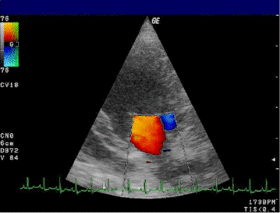| Doppler echocardiography | |
|---|---|
 | |
| MeSH | D015150 |
| OPS-301 code | 3-052 |
Doppler echocardiography is a procedure that uses Doppler ultrasonography to examine the heart.[1] An echocardiogram uses high frequency sound waves to create an image of the heart while the use of Doppler technology allows determination of the speed and direction of blood flow by utilizing the Doppler effect.
An echocardiogram can, within certain limits, produce accurate assessment of the direction of blood flow and the velocity of blood and cardiac tissue at any arbitrary point using the Doppler effect. One of the limitations is that the ultrasound beam should be as parallel to the blood flow as possible. Velocity measurements allow assessment of cardiac valve areas and function, any abnormal communications between the left and right side of the heart, any leaking of blood through the valves (valvular regurgitation), calculation of the cardiac output and calculation of E/A ratio[2] (a measure of diastolic dysfunction). Contrast-enhanced ultrasound-using gas-filled microbubble contrast media can be used to improve velocity or other flow-related medical measurements.
An advantage of Doppler echocardiography is that it can be used to measure blood flow within the heart without invasive procedures such as cardiac catheterization.
In addition, with slightly different filter/gain settings, the method can measure tissue velocities by tissue Doppler echocardiography. The combination of flow and tissue velocities can be used for estimating left ventricular filling pressure, although only under certain conditions.[3]
Although "Doppler" has become synonymous with "velocity measurement" in medical imaging, in many cases it is not the frequency shift (Doppler shift) of the received signal that is measured, but the phase shift (when the received signal arrives). However, the calculation result will end up identical.
This procedure is frequently used to examine children's hearts for heart disease because there is no age or size requirement.
- ^ "Echocardiogram". MedlinePlus. Retrieved 2017-12-15.
- ^ [1] Abdul Latif Mohamed, Jun Yong, Jamil Masiyati, Lee Lim, Sze Chec Tee. The Prevalence Of Diastolic Dysfunction In Patients With Hypertension Referred For Echocardiographic Assessment of Left Ventricular Function. Malaysian Journal of Medical Sciences, Vol. 11, No. 1, January 2004, pp. 66-74
- ^ Ommen, S. R.; Nishimura, R. A.; Appleton, C. P.; Miller, F. A.; Oh, J. K.; Redfield, M. M.; Tajik, A. J. (10 October 2000). "Clinical Utility of Doppler Echocardiography and Tissue Doppler Imaging in the Estimation of Left Ventricular Filling Pressures : A Comparative Simultaneous Doppler-Catheterization Study". Circulation. 102 (15): 1788–1794. doi:10.1161/01.CIR.102.15.1788. PMID 11023933. Retrieved 12 July 2012.